Infrastructure Needs Assessment Report
1. Introduction
Situated within the extensive Yan Yean site of Melbourne Polytechnic, the projected international campus town is expected to be a contemporary and environmentally conscious development. The campus village will occupy a portion of the 630-hectare training site, which is situated roughly four kilometers south of Whittlesea. It is located at 2005 Plenty Road, Yan Yean, Victoria. The scope of the transport infrastructure assessment holds several areas. The design of internal roads, mentioning efficient traffic flow and accessibility is one of those areas. Connectivity of internal roads, and development of active transport facilities, for example, bicycle lanes and footpaths for pedestrians. This project seeks to build on the success of Melbourne Polytechnic's Yarra House. It offers top-notch housing for students from overseas. The primary objective of this report is to evaluate the need for transport infrastructure. By attending to these requirements, the study hopes to guarantee that the transportation networks are effectively integrated. It is also efficient and compliant with contemporary sustainability norms. supporting the campus village's overall expansion and usefulness is also included. This infrastructure is needed in the campus village fully.
1.1Background: Melbourne Polytechnic's Yan Yean site, spanning 630 hectares, is an important training and education hub. The projected international campus village will be a modern, ecologically responsible addition of this property, offering first-rate accommodations and amenities to students, particularly those from abroad. This construction builds on the success of existing facilities such as Yarra House, which is known for providing excellent student living. As Melbourne grows, the expansion of educational infrastructure becomes critical to meeting rising demand. Melbourne Polytechnic's new campus village aspires to build a self-sufficient community that combines academic, residential, and recreational facilities with environmentally friendly methods.
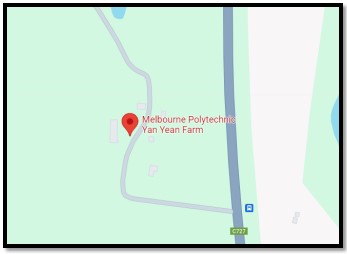

Figure 1: Yan Yean campus picture
(Source: Google Map 2024)
1.2 Scope: This research focuses on the assessment of transportation infrastructure requirements for the proposed university village. Internal road system design, connectivity to external roads, and the integration of public and active transportation choices are all critical considerations. The study will look at the requirements for effective traffic flow, accessibility, and sustainability in the campus' mobility network. It will also compare similar advances at other universities, such as the University of Queensland and the Australian National University, to discover best practices. The ultimate goal is to ensure that the transportation infrastructure promotes the campus village's growth while adhering to modern environmental requirements.
1.3 Report Objective: The objective of this paper is to assess the transportation infrastructure requirements for the projected Melbourne Polytechnic campus village. This includes building efficient internal roads, improving communication with external networks, and integrating sustainable transportation options. By comparing best practices from other institutions, the study aims to ensure that the infrastructure meets modern criteria for accessibility, traffic management, and environmental sustainability, thereby enabling the campus village's long-term expansion and functionality.
2. Focus Area: Transport Infrastructure
2.1 Internal Roads: The internal road system of the village of the mentioned university will be built with efficient traffic flow. High standards for safety and wide accessibility in mind are also maintained at the time of making (Porter 2021). The village's roads will be organized into an effective grid. This grid must reduce traffic and facilitate simple navigation. Lanes with well-marked, proper signage, and pedestrian crossing are on the list of key features. Sustainable mobility options have been effectively included by the University of Queensland (UQ) into its plans for campus development, providing useful information for the Melbourne Polytechnic campus village project. Prominent walking and cycling routes at UQ encourage low-carbon modes of transport, complementing the active transport amenities being considered for Melbourne Polytechnic. In order to solve issues with traffic volume and safety that are comparable to those found in the Melbourne Polytechnic project, UQ also uses intelligent traffic management systems that monitor and optimise vehicle flow. In keeping with the long-term goals of the Melbourne Polytechnic campus village, UQ's development also takes potential increases in the number of students and their transport demands into consideration. To improve safety for both automobiles and pedestrians, the road design will comply with safety requirements (University of Queensland, Transport. 2024). It also includes features like roundabouts and speed bumps at strategic crossings. Priority will be given to accessibility, special parking spots and ramps for those with disabilities are also included.
2.2 Connecting Roads: The campus village will be ideally situated on Plenty Road. Plenty Road is busy providing easy interaction with the current systems of transportation. The connection must be facilitated by a well-planned entry (Michalis and Vintzileou 2022). To accommodate the high traffic volumes exit points are also included. All these can provide efficient access to the campus. The incorporation of Plenty Road will provide effortless transportation (Canesi and Gallo 2023). This transportation can enhance neighboring locations and improve the university village's connectivity. Managing the increasing volume of traffic during peak hours is the most important part to maintenance. preserve orderly traffic conditions on internal and connecting roads and traffic management measures will be put into place.
2.3 Public Transport Access: A most important part of the university village's mobility network or the transport system will be future public transport alternatives. By this study the possibility of developing bus services to link the campus with surrounding train stations. Other important locations will be investigated throughout the study (Basu et al. 2020). With a significant emphasis on transit infrastructure, the Australian National University (ANU) has been reviving its campus, providing pertinent parallels for the Melbourne Polytechnic campus village proposal. The interior road systems of ANU have been renovated with pedestrian crossings and well-marked lanes to improve safety and accessibility. The design is reminiscent of Melbourne Polytechnic's proposed grid structure. Furthermore, ANU has strengthened its links to public transportation, making sure that bus schedules coincide with peak hours an important component of the mobility planning for the Melbourne Polytechnic project. ANU's renovation also makes use of sustainable products and methods, which is in accordance with the campus village's sustainability objectives (Australian National University, Campus Development Services. 2024). To improve connectivity and accessibility for users, this bus service might be planned to run during peak hours. It also coincides with local public transportation schedules.
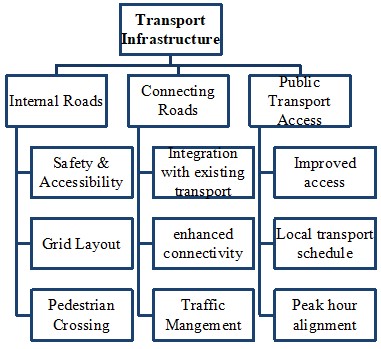
Fig 1: Overview of Transport Infrastructure Focus Areas
(Source: Self Developed)
3. Strategic Direction
For the assigned campus village the transport infrastructure will be maintained by the proper management system. This management system will prioritize the full life cycle of the mentioned assets. In the time of planning phase, it can align the infrastructure with long-term growth. Improvement as per the transport needs is also included. Best practices will be preferable during construction to ensure longevity and security (Argyroudis et al. 2020). Road safety and traffic flow optimization will be the key priorities of this transport maintenance. Under the maintenance strategy regular inspections, prompt repairs, and upgrades based on performance data will be the most important part. Sustainable goals must be at the center of the transport infrastructure design. Traffic management and decreasing environmental impact are known as smart technologies. Utilizing sustainable materials is also part of smart technologies. There are also some active transport facilities such as pedestrian paths and bicycle paths (Chandrashekhar et al. 2020). Low-carbon commuting options are also promoted by such incorporated facilities. It can also commit to sustainability and resilience.
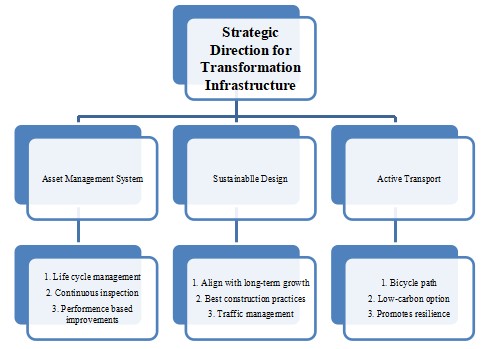
Fig 2: Strategic Direction for Transport Infrastructure
(Source: Self-Developed)
3.1 Policy: The Melbourne Polytechnic campus village's transportation infrastructure will be directed by a sustainable, accessible, and safe strategy. The emphasis will be on decreasing environmental impact by encouraging low-carbon transportation options like as cycling and walking, as well as ensuring that all transportation facilities are accessible to those with disabilities. The policy also prioritizes maintaining a high level of safety through frequent inspections, rapid repairs, and the use of smart technologies to control traffic more efficiently and reduce accidents.
3.2 Objectives: The strategic direction for the university village's transportation infrastructure includes the following primary objectives:
- Ensure Efficient Traffic Flow: Create a well-organized internal road network to reduce congestion and improve vehicle flow.
- Encourage Active Transport: Create extensive pedestrian walkways and bicycle lanes to promote walking and cycling as key modes of transportation.
- Improve Connectivity: Connect the campus to existing external road networks and public transportation systems, ensuring easy access to and from the community.
- Prioritize Safety and Accessibility: Create infrastructure that accommodates all users, including those with disabilities, while adhering to the greatest safety standards via smart traffic management systems.
- Support Sustainable Development: Use environmentally friendly materials and technologies to construct a resilient, future-proof transportation infrastructure that is consistent with long-term sustainability objectives.
4. Level of Service
By proposing high standards in road capacity, safety, and accessibility, the mentioned campus village can highlight its level of service. The capacity of the roads will be planned to handle high traffic volumes. It can be manipulated without creating gridlock, guaranteeing easy access for cars all across the campus. Strict safety regulations will be implemented to incorporate elements (Young et al. 2022). Illuminated roadways and lucid signage are examples of incorporating elements. Pedestrian crossings and traffic calming strategies are also included. Ensuring smooth connectivity throughout the campus will be a top focus. Making this seamless connectivity roads and pathways built to accommodate the needs of all users. Those impairments are also included. All types of maintenance activities would be tracked. The reason behind the tracking is to ensure upgrades and timely repair. Measuring metrics and keeping an eye on the optimal conditions are also added to the track. Through consistent measurement of these parameters, the transport infrastructure will be modified. It was also enhanced over time to meet the changing needs of the campus village. All these are maintained to ensure a high level of service.
5. Future Demand
5.1 Short Term (5 years): During the initial phase the campus village is anticipated to house 300 students in three buildings. To accommodate this occupancy, the transportation infrastructure must have enough parking places. Enough road capacity and accessibility to public and active transportation choices are also included. There can be a little increase in car and pedestrian traffic. This enhancement will happen when the campus is fully operational. Fully operational is defined as effective traffic control and monitoring systems.
5.2 Medium Term (10 years): by the next decade the student population will increase. For this, the demand for on-campus accommodation will also extend. To accommodate this increase, more parking spaces and internal road extensions are needed to upgrade. developed public transportation options will also need to be added to the transportation infrastructure. To handle increasing traffic numbers, the college would need to install seamless traffic control technologies.
5.3 Large Term (20 years): In a prolonged period of twenty years transport patterns and technology have advanced. The village may continue to develop. necessitating the construction of new transport systems, improved public transportation, and larger active transportation infrastructure are also in the way to develop. Ensuring that the infrastructure is future-proof and capable of keeping up with changing needs and technology advancements will require careful planning for these modifications.
Here is the table that summarize the future demand for transport infrastructure in the campus village over short, medium, and long-term periods,

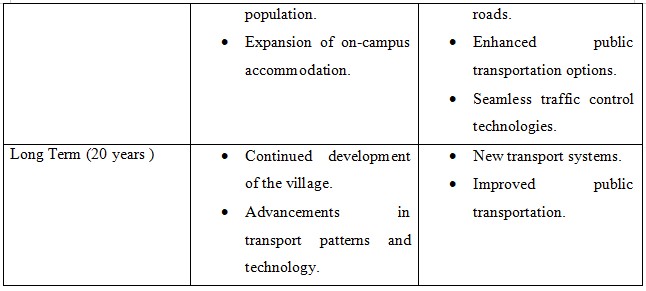
6. Collecting Asset Information
In the phase of data collection, some processes need to be maintained. For example, field surveys, digital mapping, and stakeholder discussions are the most important ways to gather information. In this current purpose field survey would be the best way. The reason behind this is to determine proper sites for parking lots, bicycle paths pedestrian paths, and transport facilities. Based on the information received, plan for enough on-street parking to accommodate students, visitors, and staff. The goal would be to supply approximately 1.5 parking spaces per student unit, in accordance with basic urban planning guidelines for such facilities. Traffic counts and improvements in road measurement will also be part of these surveys. The campus layout will be meticulously mapped using digital mapping methods. For instance, Geographic Information Systems (GIS), to pinpoint important transportation corridors and facilities.
7. Monitoring Asset Performance and Condition
Regular inspections, planned maintenance, and performance evaluations will all be part of a systematic strategy. All these are included to monitor the functionality and state of the campus village's mobility infrastructure. Transport infrastructure, parking structures, and active transportation routes will all undergo routine inspections (Tonn et al. 2020). This inspection happened to detect signs of deterioration, safety risks, and new problems. Based on these inspections a maintenance plan will be created.
Rate of Quality Chart
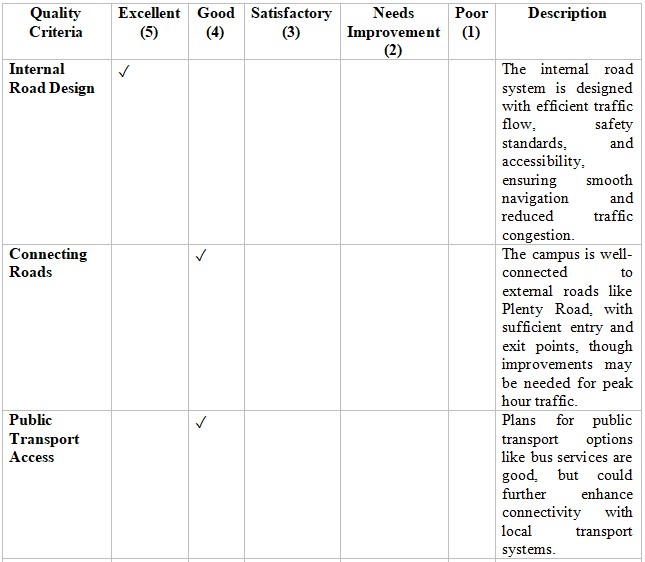
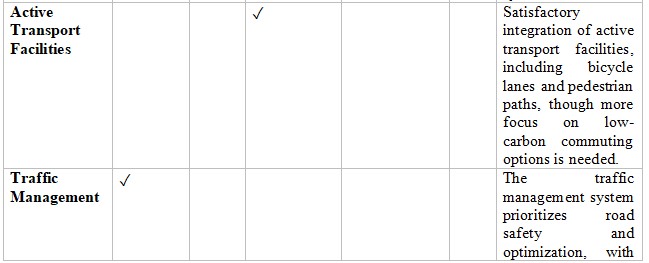
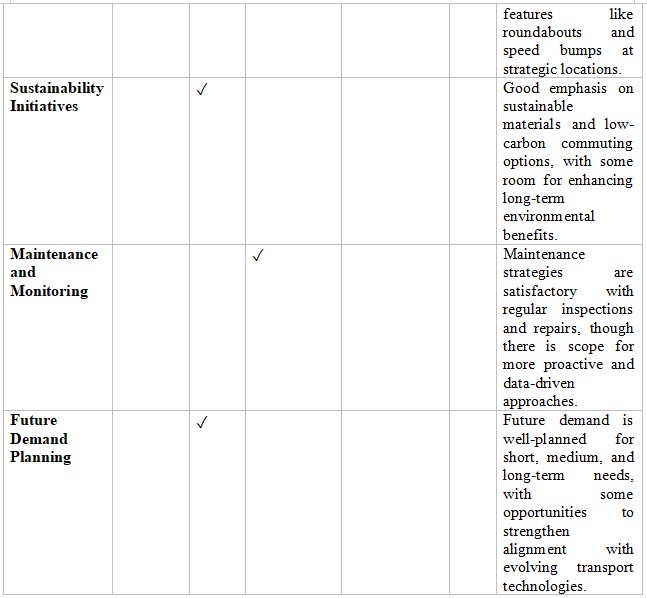
The assessment scores well on most areas, with notably high grades for internal road design and traffic management. Public transportation access, connecting highways, and environmental programs are examples of smart planning that might be improved further. Active transportation facilities and maintenance procedures are adequate, but long-term improvements require a greater attention.
8. Conclusion
A complete internal transport infrastructure holds smooth access to main roads. There is a wide range of public and active transport alternatives which are all vital requirements for the projected college community. All these requirements are proposed as per the transport infrastructure evaluation. After confirming some requirements the village ensures a few objectives. Benefits, accessibility, and the long-term sustainability of the campus village are under those requirements. It was previously mentioned about the key proposals. Here are some of the key proposals: an efficient traffic management system, forward-thinking planning, and technological innovations. The integration of sustainable transport is also included in the key proposals for the future. The campus village will be positioned as an example of contemporary, sustainable growth in educational infrastructure. If these suggestions are put into practice going forward then it will also improve the entire student experience.
Are you struggling to keep up with the demands of your academic journey? Don't worry, we've got your back!
Exam Question Bank is your trusted partner in achieving academic excellence for all kind of technical and non-technical subjects. Our comprehensive range of academic services is designed to cater to students at every level. Whether you're a high school student, a college undergraduate, or pursuing advanced studies, we have the expertise and resources to support you.
To connect with expert and ask your query click here Exam Question Bank

